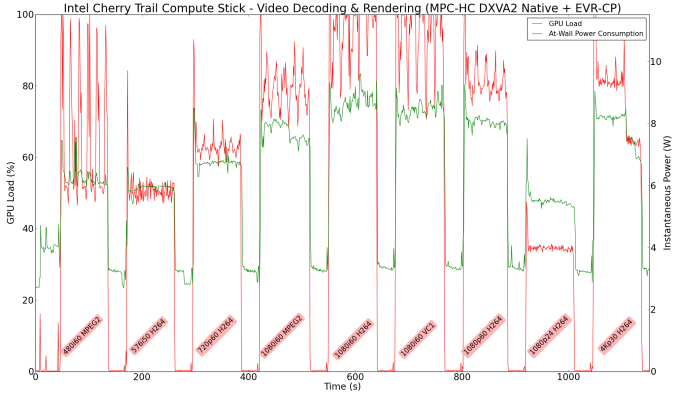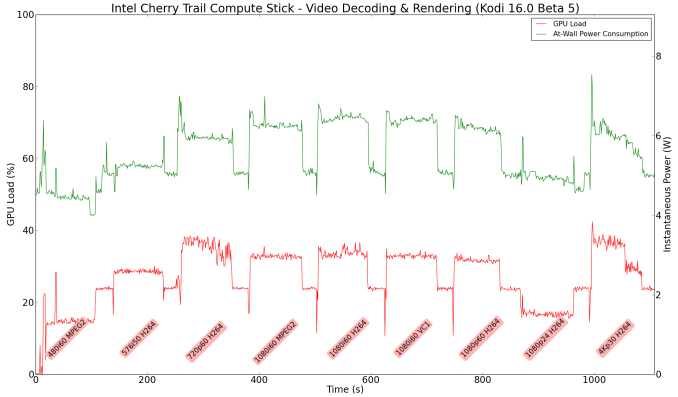The Intel Compute Stick (Cherry Trail) Review
by Ganesh T S on January 14, 2016 8:00 AM EST- Posted in
- Systems
- Intel
- Cherry Trail
- HDMI Stick
- CES 2016
- Compute Stick
HTPC Credentials
Usage of the Compute Stick as an entertainment platform is promoted by Intel as one of the use-cases. It is a bit surprising (given the form factor) that the Compute Stick has a fan. In this aspect, the Cherry Trail unit is no different from the Bay Trail unit. Subjectively, I was not comfortable with the acoustics in a 'office scenario' with the Compute Stick at the base of the monitor (connected via the HDMI extender cable) and myself seated around 70 cms. from it. The small diameter of the fan makes for a whining high-pitched noise, and it is compounded by the fact that it starts and stops depending on the SoC load.
Objectively speaking, Intel provided an acoustics rating of 28 dB at 1m distance for the noisiest mode. If the Compute Stick were to be hidden behind the TV, it is unlikely that users can hear such low noise at typical television viewing distances. It is not ideal, but Intel indicated that the performance of the device needs proper thermals. In order to to balance the very small size along with overall cost and performance, they decided to retain a small fan as the optimal thermal solution. Now that we have got the acoustics out of the way, let us move on to the other HTPC aspects.
Refresh Rate Accurancy
Starting with Haswell, Intel, AMD and NVIDIA have been on par with respect to display refresh rate accuracy. The most important refresh rate for videophiles is obviously 23.976 Hz (the 23 Hz setting). As expected, the Intel PPSTK1AW32SC has no trouble with refreshing the display appropriately in this setting. It actually performs better than the Bay Trail unit in this respect.
The gallery below presents some of the other refresh rates that we tested out. The first statistic in madVR's OSD indicates the display refresh rate.
Network Streaming Efficiency
Evaluation of OTT playback efficiency was done by playing back our standard YouTube test stream and five minutes from our standard Netflix test title. Using HTML5, the YouTube stream plays back a 720p encoding. Since YouTube now defaults to HTML5 for video playback, we have stopped evaluating Adobe Flash acceleration. Note that only NVIDIA exposes GPU and VPU loads separately. Both Intel and AMD bundle the decoder load along with the GPU load. The following two graphs show the power consumption at the wall for playback of the HTML5 stream in Mozilla Firefox (v 43.0.4).

GPU load was around 37.44% for the YouTube HTML5 stream and 11.14% for the steady state 6 Mbps Netflix streaming case.
Netflix streaming evaluation was done using the Windows 10 Netflix app. Manual stream selection is available (Ctrl-Alt-Shift-S) and debug information / statistics can also be viewed (Ctrl-Alt-Shift-D). Statistics collected for the YouTube streaming experiment were also collected here. While YouTube was more power efficient on the Cherry Trail Compute Stick, the Netflix case is the other way round. However, the numbers taken standalone do point to the Compute Stick units being a very power efficient platform for OTT streaming.

Decoding and Rendering Benchmarks
The form factor of the Compute Stick and the internal components make it clear that consumers are not going to play back videos using the madVR renderer. Instead, it is highly likely that Kodi will be used as the interface for media playback. We evaluated performance under MPC-HC + EVR-CP and Kodi 16.0 (Beta 5) for our test suite. Prior to those results, let us take a look at the codecs that are hardware-accelerated by the Cherry Trail SoC.
As expected, we have acceleration for MPEG-2, VC1, WMV9 and H.264. Interestingly, we also have support for HEVC (8-bit) and VP9 hardware-accelerated decoding in the upgraded GPU.
In our earlier reviews, we focused on presenting the GPU loading and power consumption at the wall in a table (with problematic streams in bold). Starting with the Broadwell NUC review, we decided to represent the GPU load and power consumption in a graph with dual Y-axes. Nine different test streams of 90 seconds each were played back with a gap of 30 seconds between each of them. The characteristics of each stream are annotated at the bottom of the graph. Note that the GPU usage is graphed in red and needs to be considered against the left axis, while the at-wall power consumption is graphed in green and needs to be considered against the right axis.
Frame drops are evident whenever the GPU load consistently stays above the 85 - 90% mark. In addition to tracking that aspect in the graphs below, we also get an idea of the system's power efficiency for decode and playback of some common codecs.
The above graph suggests that the Compute Stick is likely to drop frames when deinterlacing of high frame rate content is required. It is possible that EVR, the native renderer, will perform better than EVR-CP.
Kodi doesn't deinterlace content by default - so, the GPU load never goes unreasonably high. In the Bay Trail Compute Stick, Kodi struggled with the 1080i60 streams. Another aspect to observe with Kodi is that 'idling' at the XBMC interface consumes around 25% of the GPU resources and the power penalty is around 5 W. Depending on the codec and frame rate, the GPU load and power consumption might be lower or higher than the 'idle' state. For example, 480i60 and 1080p24 videos play back within the 5 W power envelop.
Note on HD Audio Bitstreaming
As of January 2016, the Intel graphics drivers for Cherry Trail (32-bit) have support only for bitstreaming of DTS, Dolby Digital and Dolby Digital Plus. This means that Netflix and other similar OTT sites are in the clear. However, users hoping to take advantage of lossless HD audio in Blu-ray backups are going to be disappointed. However, given the other limitations of the form factor and the system, it is unlikely that the absence of HD audio bitstreaming will bother too many consumers.




















80 Comments
View All Comments
augman2384 - Thursday, January 14, 2016 - link
Are you going to review the Kangaroo PC? It's also Cherry Trail and has other similarities but priced much cheaper at $99. It would be interesting to see it compared in the benchmarks.Wombat2013 - Thursday, January 14, 2016 - link
Yes, a Kangaroo PC review would be interesting/useful.KenA - Friday, January 15, 2016 - link
I picked up a Kanagroo PC at newegg for $99. It's great. And it has 4K Hdmi! I use it on my Vizio 4K 43" TV.ToTTenTranz - Thursday, January 14, 2016 - link
Well a high-pitch fan in a product like this is really a huge turn-off...One question and one request that may be of interest to many users:
1 - It won't pass-through DTS-HD or Dolby TrueHD, but does the HDMI sound codec support a linear-PCM output up to 7.1, and if so can it decode the compressed lossless formats and send through 24bit PCM?
2 - Please, if not for this review then at least for the next ones, could you include a test with Steam In-Home Streaming in your suite?
ganeshts - Thursday, January 14, 2016 - link
Yes, it supports Linear PCM, Dolby Digital, DTS and Dolby Digital Plus up to 5.1 for sure. I will check and report on 7.1 later tonight.I have to check on the Steam In-Home Streaming - if there is a typical benchmark that can quickly assess the capabilities. If I need to have another PC running Steam and actually need to launch a game and play, then I fear it might be too much overhead to our benchmarking routine.
ToTTenTranz - Thursday, January 14, 2016 - link
Thanks for the clarification! Then it's probably a matter of licensing alone.As for In-Home Streaming, you can just start a timedemo from any game from the client PC and watch the network statistics in it (it's an option in the In-Home Streaming settings).
Since IHS supports the execution of pretty much any executable from the host PC, you can probably just run your already existing batch file from there.
jasonelmore - Friday, January 15, 2016 - link
its a simple streaming test. What quality setting can it do? You can measure FPS. Use a game that gets good frame-rates like Portal 2 or TF2. As long as the Steam PC can do 60 FPS, then all of the other variables are moot.Use a usb ethernet adapter
BillyONeal - Thursday, January 14, 2016 - link
Typo:maintaining a similar power envelop
->
maintaining a similar power envelope.
bill.rookard - Thursday, January 14, 2016 - link
Very cool little devices, and while I can appreciate the tiny form factor, it still doesn't seem to be as good as my Raspberry Pi quad core running OpenELEC, especially when factoring in the price.Shadowmaster625 - Thursday, January 14, 2016 - link
At any given moment, there are a dozen Z8300 equivalent tablets on sale for less than $200. As messed up as it is, I doubt we will ever see prices on these compute sticks go lower than the sale prices of atom tablets.